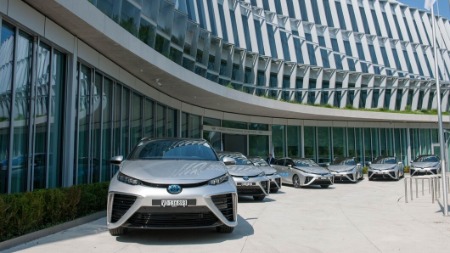Opinion - November 26, 2019
The Hydrogen Car - here and now, not just for the future


Written by Bertrand Piccard 4 min read
In two days, I have covered 778 kilometers, emitting nothing more than water vapor. I drove through two countries – France and Luxembourg – driving a hydrogen car, a standard Hyundai Nexo. I did this on just one full tank, setting a new world distance record for this kind of clean mobility.
Through this achievement, I want to transmit a clear message: already today, you can get around under hydrogen power. In California, in Japan and in France, hydrogen fuel stations are under construction. In Germany, the first hydrogen trains were introduced last year, replacing diesel trains. Cars, trucks and buses that run on hydrogen are already on our roads; and NASA researchers are exploring the possibility of powering an aircraft with nothing but hydrogen.
However, this technology still has many detractors who want battery-driven electric vehicles to retain a monopoly on clean mobility. In fact, although hardly any doubt remains that electrification is the best way to decarbonize our modes of transport, a battle is raging between electric cars powered by battery and by hydrogen.
To understand all this better, it is important to remember that hydrogen is a form of energy storage. Both battery and hydrogen cars are electric. But whereas in the first the electricity required is stored in a battery, in the second it is generated from the hydrogen in a fuel cell.
For my part, I firmly believe that battery and fuel cell electric vehicles, far from being in competition, complement each other perfectly as means of transport. All depends on the distances to be covered. The battery is an ideal solution for short journeys, whereas hydrogen is better suited for long journeys. Indeed, the range a hydrogen vehicle can achieve is one of its main advantages over battery vehicles, as I have just demonstrated with this record.
Another important advantage of this technology is that hydrogen can make friends where batteries are making enemies. In particular, oil companies can be involved in the manufacture, transportation, distribution and sale of hydrogen, whereas they are in competition with the battery sector. As for the vehicle users, they appreciate the short refueling time for hydrogen vehicles - only a few minutes are needed to fill the tank, as for vehicles with combustion engines. Finally, it is much easier for governments to tax hydrogen than battery electricity.
Of course, hydrogen still has challenges to overcome to become commonly accepted on our roads, such as the number of refueling stations, the transport of the gas, and the price of the vehicles. But many innovations already exist to solve these challenges. Several have been certified by the Solar Impulse Foundation, which promotes clean and profitable technologies.
On the availability of refueling stations, for example, the hydrogen taxi company Hype has signed a partnership with Air Liquide group ensuring that vehicles and stations come into service at the same time. This will allow Hype to refuel its vehicles and Air Liquide to have guaranteed customers. HySiLabs has developed a technology that allows hydrogen to be converted from a gaseous to a liquid state, making it easier to transport and store. For their part, car manufacturers are investing heavily to minimize the cost of hydrogen vehicles and facilitate their adoption by consumers.
Given that innovators are doing their part, it is now up to the policy makers to deliver on their promises. Governments around the world have announced plans to invest in the hydrogen industry. France and Germany have investment plans of several hundred million euros, China plans 1 million hydrogen vehicles on its roads by 2030, Japan wants to build nearly 10,000 hydrogen stations in the next decade…
If governments are banking on hydrogen, the innovators are developing solutions, and the costs of buying and recharging vehicles are falling dramatically, it is now up to consumers to make their choices and decide the outcome of the battle over clean mobility. One thing is certain: flying a solar plane around the world required some special piloting skills, but any car driver can attempt to break my hydrogen vehicle distance record.
Bertrand Piccard, President Solar Impulse Foundation

Written by Bertrand Piccard on November 26, 2019


